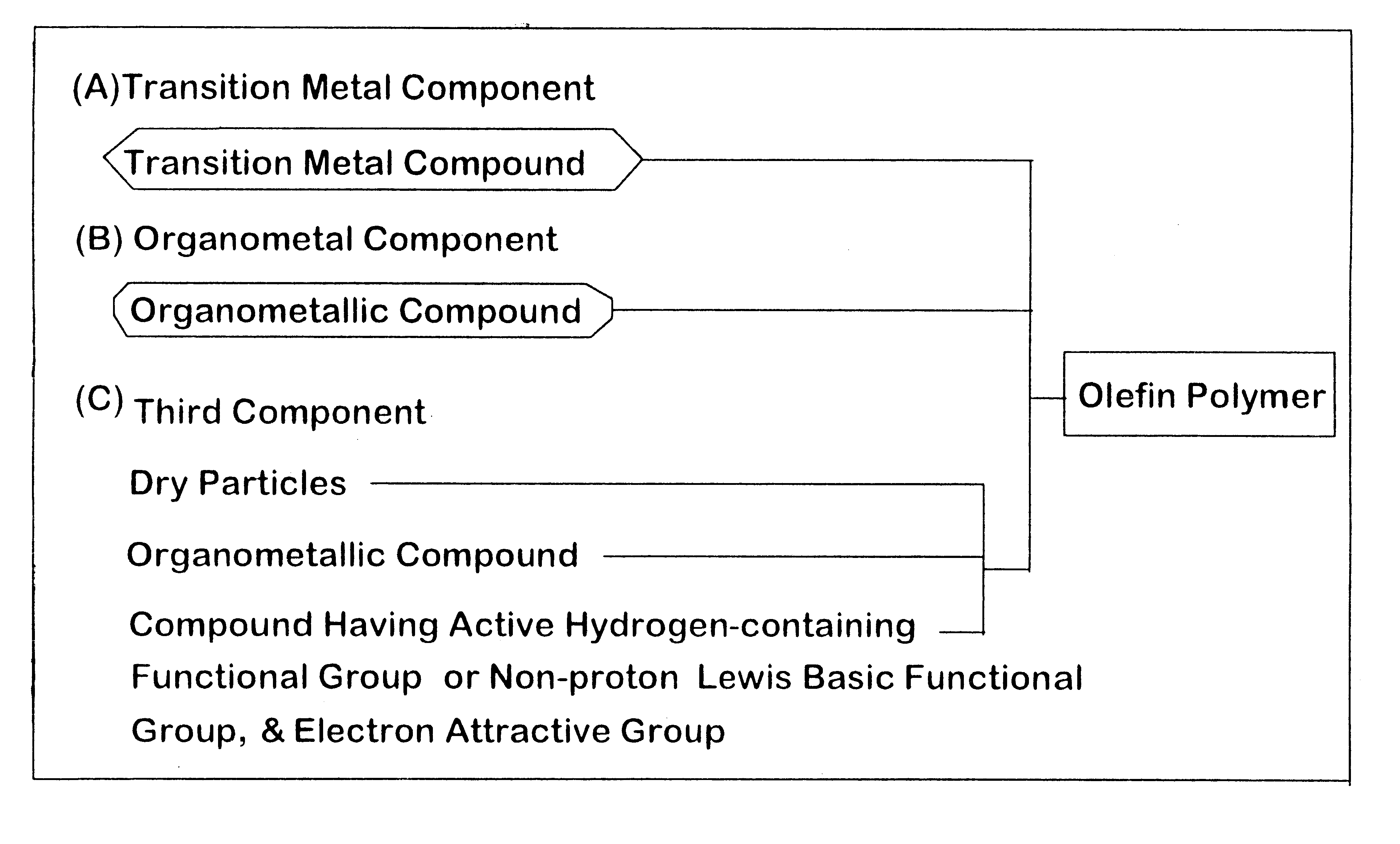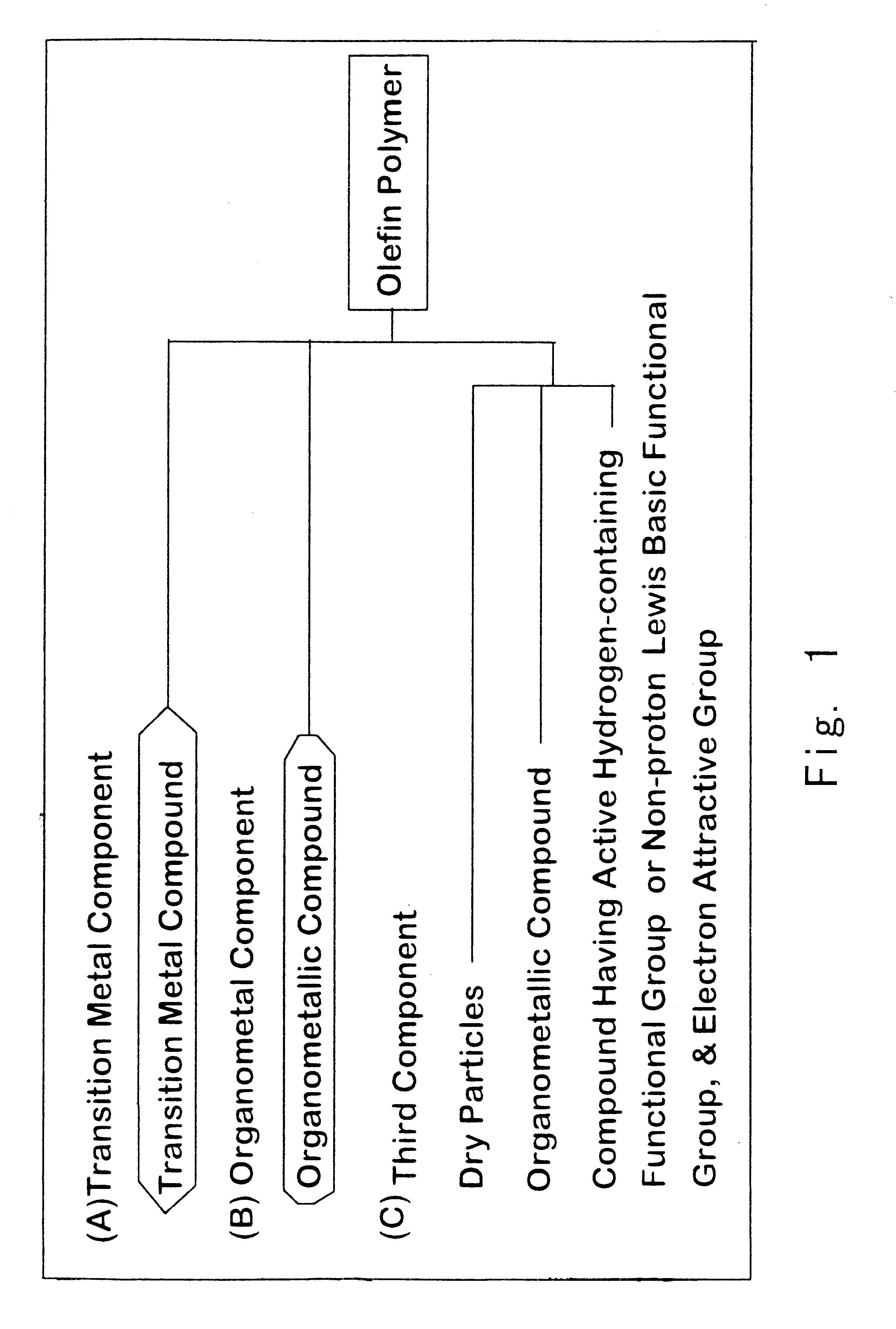Modified particles, carrier prepared therefrom, olefin polymerization catalyst component prepared therefrom, olefin polymerization catalyst prepared therefrom, and process for preparing olefin polymer
a technology for olefin polymerization catalysts and modified particles, which is applied in the field of modified particles, carrier preparations, and olefin polymerization catalyst components prepared therefrom, and the process of preparing olefin polymer. it can solve the problems of poor heat, lowering productivity, and difficulty in stable operation
- Summary
- Abstract
- Description
- Claims
- Application Information
AI Technical Summary
Benefits of technology
Problems solved by technology
Method used
Image
Examples
example 1
(1) Contact Treatment of Particles (a) with Organometallic Compound(b)
The atmosphere in a 200 ml four necked flask equipped with a stirrer, a dropping funnel and a thermometer was dried under reduced pressure and then replaced with nitrogen. 5.51 g of silica (manufactured by CROSFIELD Co., Ltd., ES70X, average diameter: 48.0 .mu.m, pore volume: 1.61 ml / g, specific surface area: 290 m.sup.2 / g) heat-treated under a nitrogen flow at 300.degree. C. for 5 hours was charged in the flask. Then, 100 ml of toluene was added to form a slurry, the slurry was cooled to 5.degree. C. in an ice bath and 11.0 ml of a toluene solution of trimethylaluminum whose concentration was adjusted to 1 mmol / ml was slowly added dropwise thereto. In that case, a gas was evolved. After stirring at 5.degree. C. for 30 minutes, then at 80.degree. C. for 2 hours, the supernatant was removed by filtration and the residual solid compound was washed four times with 100 ml of toluene and then washed twice with 100 ml ...
example 2
(1) Contact Treatment Between Particles (a) and Organometallic Compound (b)
A 500 ml four neck flask equipped with a stirrer, a dropping funnel and a thermometer was dried under reduced pressure and then replaced with nitrogen. 45.0 g of silica (manufactured by CROSFIELD Co., Ltd., ES70X) heat-treated under a nitrogen flow at 300.degree. C. for 5 hours was charged in the flask. Then, 250 ml of toluene was added to form a slurry, which was cooled to 5.degree. C. in an ice bath and 90.0 ml of a toluene solution of trimethylaluminum whose concentration was adjusted to 1 mmol / ml was slowly added dropwise. In that case, a gas was evolved. After stirring at 5.degree. C. for 30 minutes, then at 80.degree. C. for 2 hours, the supernatant was removed by filtration and the residual solid compound was washed four times with 250 ml of toluene and then washed twice with 250 ml of hexane. Thereafter, the solid compound was dried under reduced pressure to obtain 46.0 g of a flowable solid compound....
example 3
(1) Contact Treatment Between Particles (a) and Organometallic Compound (b)
A 200 ml four neck flask equipped with a stirrer, a dropping funnel and a thermometer was dried under reduced pressure and then replaced with nitrogen. 10.7 g of silica (manufactured by CROSFIELD Co., Ltd., ES70X) heat-treated under a nitrogen flow at 300.degree. C. for 5 hours was charged in the flask. Then, 110 ml of toluene was added to form a slurry, which was cooled to 5.degree. C. in an ice bath and 21.4 ml of a toluene solution of triethylaluminum whose concentration was adjusted to 1 mmol / ml was slowly added dropwise. In that case, a gas was evolved. After stirring at 5.degree. C. for 30 minutes, then at room temperature for 2 hours, the supernatant was removed by filtration and the residual solid compound was washed four times with 100 ml of toluene and then washed twice with 100 ml of hexane. Thereafter, the solid compound was dried under reduced pressure to obtain 11.1 g of a flowable solid compoun...
PUM
| Property | Measurement | Unit |
|---|---|---|
| Angle | aaaaa | aaaaa |
| Length | aaaaa | aaaaa |
| Length | aaaaa | aaaaa |
Abstract
Description
Claims
Application Information
 Login to View More
Login to View More - R&D
- Intellectual Property
- Life Sciences
- Materials
- Tech Scout
- Unparalleled Data Quality
- Higher Quality Content
- 60% Fewer Hallucinations
Browse by: Latest US Patents, China's latest patents, Technical Efficacy Thesaurus, Application Domain, Technology Topic, Popular Technical Reports.
© 2025 PatSnap. All rights reserved.Legal|Privacy policy|Modern Slavery Act Transparency Statement|Sitemap|About US| Contact US: help@patsnap.com


